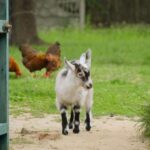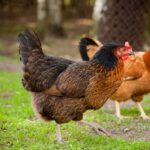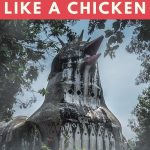It’s a common question when you first look at a chicken. What is the red thing on a chicken?
It looks like they have some kind of spiky flesh on their heads and another red dangly thing on their chins.
Well, if you’re asking these questions you’ve come to the right place.
I can explain what all the red things on a chicken's head are, and what purpose they serve.
Let’s start by adding the correct names to each of the red bits on a roosters or hens head:
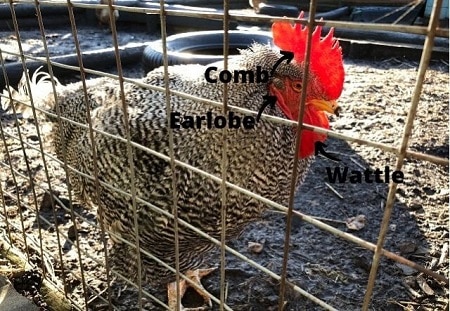
Table of Contents
What Is the Red Thing on a Chicken's Head?
As you can see from the image above, the red thing on the top of a chicken’s head is called a comb.
This is because it looks like a comb, you can see the similarity right?
Their combs help them keep cool in the summer. Chickens don’t have sweat glands and can’t sweat like we do to cool down.
Instead, they use something called evaporative cooling. This involves turning moisture on the surface of their lungs into vapor and increasing the blood flow to their combs.
A nice bright red comb is also a sign that the chicken is healthy. If their comb is turning black or purple, it’s a sign of illness.
This video does a good job of explaining how a chick's wattle help cool them down and how chickens regulate their body temperature:
What Is the Red Thing on a Chicken's Chin?
The red thing hanging off a chicken’s chin is called a wattle.
Wattles have the same functions as combs. They help regulate a chicken’s temperature by increasing the flow of blood when they’re too hot and are also a way you tell if they are having health issues.
What Is the Red Thing Dangling Near a Chicken's Ear?
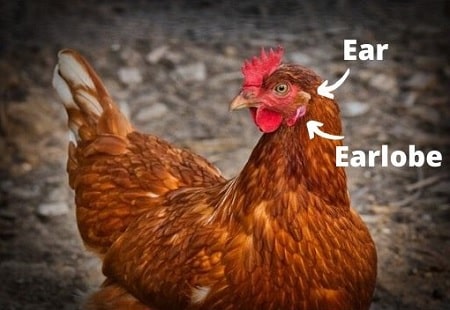
The red thing dangling where their ears should be is their earlobes
.It’s hard to see a chicken’s actual ear, although they do have an inner, middle and outer ear similar to how we do.
Their ear opening is a small hole and is usually covered with feathers. But there is no mistaking their earlobes, it’s those large red things hanging on the side of their heads.
If you’re interested in learning more about chicken’s ears I wrote a couple of interesting posts;
- How you can determine the color of eggs a chicken will lay by looking at the color of their earlobes?
- Where are chicken’s ears located?
Different Types of Chicken Combs
A chicken’s comb comes in all kinds of shapes and sizes. There are even a few different names to describe combs, which helps breeders and chicken farmers describe what they want.
Here are the 9 main types of comb:

Pea Comb
Pea combs, as the name suggests look like a line of peas across the top of a chicken’s comb. They are typically smaller combs overall, making them less susceptible to frostbite during winter.
Check out breeds like the Brahmas, Buckeyes, and Ameraucanas if you want a pea combed bird.
Strawberry Comb
Strawberry combs are perfectly named, sometimes they really do look like the chicken has a strawberry sitting on their forehead. It’s amazing sometimes.
Check out breeds like Yokohamas and Malays if you want a strawberry combed bird.
Cushion Comb
Cushion combs round, small, and solid with no ridges or points. A bit like a small strawberry comb, but typically smoother.
Check out breeds like the Chantevlers if you want a cushion combed bird.
Single Comb
This is the comb everyone is the most familiar with as it’s the most popular style sitting atop the heads of the most well-known breeds.
Check out breeds like Leghorns, Rhode Island Reds, and Barnevelders if you want a single combed bird.
Walnut Comb
Another descriptive name that is exactly what it sounds. Walnut combs look like the shell of a walnut, sometimes are huge and quite unsightly, too.
Check out breeds like Silkies and Orloffs if you want a single combed bird.
Rose Comb
This is one of the more interesting looking combs. It looks like a pointy tube that runs from the top of the beak to the back of their heads forming a tip or a spike at the end.
There is usually a cluster of the fleshy comb at the top of the beak, too.
Check out breeds like Rose Comb Brown Leghorns, Sebrights, and Silver Laced Wyandottes if you want a rose comb bird.
Buttercup Comb
The Buttercup comb is exclusive to the Sicilian Buttercup breed. It’s a magnificent looking comb. Crown-like as it forms a full circle, and is also best described as a single comb split into two.
Carnation Comb
Also called “Kings” this comb is very similar to the Single comb, with the main difference being it continues further round the head with some points on the back of the chicken’s head.
There are only two breeds with Carnation combs; Penedesenca and Empordanesa.
V-Shaped Comb
This is my personal favorite comb shape. It’s obviously a “V” shape but looks like a pair of horns or evil eyebrows if you ask me. A bit sinister-looking, but adds character to the facial expressions of a chick.
Check out breeds like the Polish, Mottled Houdans, and Sultans if you want a V-Shaped combed bird.
Why Do Chickens Have Combs and Wattles?
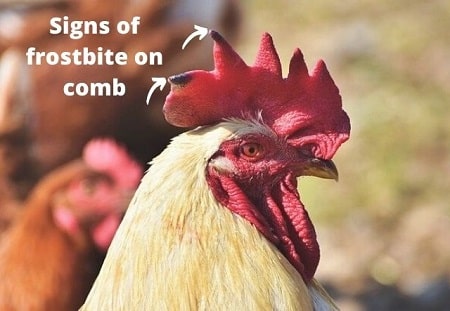
The primary use of combs and wattles on chickens is to help regulate their temperature.
Because they can’t sweat, they are prone to heat stress in extreme temperatures and it’s harder for them to cool down than it is for us.
One of the ways they can accelerate cooling down is to pump more blood flow through their combs and wattles.
This enables them to transfer heat to the surrounding air. It sounds like it wouldn’t do a lot, but to a small chicken, this can make all the difference needed.
The downside is that their combs are susceptible to frostbite as it’s a thin, fleshy organ exposed to the cold air.
Their combs will change color to indicate their general health and stages of their development. For example, a molting hen will usually have a pale comb, and a bright red comb is an indication they are laying well.
For roosters, combs and wattles have an additional meaning. Much like many animals - peacocks come to mind - the size and color of their combs and wattles will attract hens to mate with.
In Summary
You’re now an expert in the anatomy of a chicken’s head. You no longer need to refer to wattles and combs as “red things” and “dangly bits”.
I think combs look really impressive, especially the large spiky ones. Understanding they also play an important role in the health of a chicken is also interesting. It’ll help you keep an eye on the health of your flock if you have backyard chickens.


